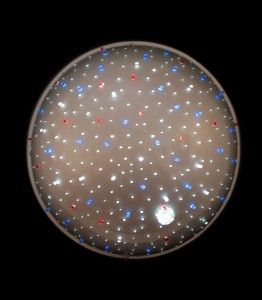ART FROM OUTER SPACE: GYULA KOSICE'S AEROLITO MADÍ
 |
Gyula Kosice’s Aerolito Madí (Madí Meteorite) expresses the artist’s vision of the universe. How do we view outer space? The night sky is one of the few natural phenomena visible to the human eye from nearly every spot on earth. In 1988, when Kosice created the Aerolito Madí, images of the universe were already available from space telescopes. Today, we have far more images to contemplate. (See below for a gallery of photographs from the Hubble Space Telescope.) Spectacular though these images are, nearly all of them have been recolored because so much of the light in outer space is invisible to the human eye.
With the Aerolito Madí, Kosice uses color and light to invoke the wonders of astronomy. Outer space makes up the realm beyond our known reality, and Madí artists created utopian works with the aim of inspiring the public to think beyond their present circumstances.
Before creating your own Aerolito, think carefully about how the night sky appears. What colors do you see? Which stars and planets can you identify? Make pencil drawings of the different galactic formations you find most beautiful. Experiment with color to explore the full spectrum of the sky.
* The Evolving Universe website (link at the bottom of this page) may help you to better understand the images of the universe you have seen.
An Aerolito can be made with common, inexpensive materials. Let’s begin.
You will need:
- 1 piece of foam board measuring at least 15cm x 15cm (6"x6")
- 1 bottle of non-toxic black paint
- 2 paint brushes
- 1 small jar of glow-in-the-dark paint
- 20-30 pushpins (clear and colored)
- A circular object approximately 12cm (5″) in diameter (not pictured) or a compass
- A pen or marker with black ink (not pictured)
Step 1. Place the circular object in the middle of the piece of foam board. Use the pen or marker to trace around it, making a circle. Alternatively, draw the circle with a compass.
Step 2. Fill the circle with a coat of black paint.
Step 3. Once the paint has dried, fill the painted space with pushpins. Choose the colors that best describe the universe to you! (Here, we used colors similar to those in Kosice’s Aerolito: clear, blue, and red.)
Step 4. Using a small, clean paintbrush, cover the tops of the pushpins with two coats of glow-in-the-dark paint.
Step 5. Paint the rest of the foam board black.
Step 6. When the first coats of paint have dried, check to see if either the foam board or the pushpins needs more paint. The paint should completely cover each surface.
Congratulations –- you have created your own Aerolito! To “charge” the glow-in-the-dark paint, place your new Aerolito in a brightly lit place for a few hours. Then at night, turn out the lights and see your universe glow!
Other ideas:
Try more combinations of pushpins to see how different colors reflect the universe. Experiment with pushpins of different sizes and shapes. Add streaks of colored and glow-in-the-dark paint on top of the black background. For inspiration, here are some recent images of outer space:
External links:
- Gyula Kosice's official webpage (in English and Spanish)
- Images from the Hubble Space Telescope - This is a telescope that orbits our planet, taking images of the universe from beyond the earth's atmosphere. The gallery above contains a few of the many images available on this website.
- The Evolving Universe - A joint project of the Smithsonian National Museum of Natural History and the Smithsonian Astrophysical Observatory. The website includes videos and photographs of outer space, as well as information about our solar system, galaxy, and universe. The "Behind the Science" section features information for artists and astronomers both young and old.
Lesson plan by Sandra R. Schachat. Photo credits: Art Museum of the Americas, Jessie Gordon.






















